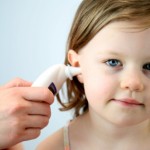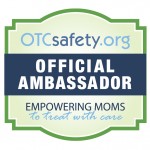 I recently received a message from a friend wanting to know the best way to take her child’s temperature. She felt like her child was burning up, but her ear thermometer only read 101 F. My friend was certain by looking at her child (who was feeling pretty lousy) and doing the “kiss on the forehead” check, that her child’s temperature was most definitely higher than that.
I recently received a message from a friend wanting to know the best way to take her child’s temperature. She felt like her child was burning up, but her ear thermometer only read 101 F. My friend was certain by looking at her child (who was feeling pretty lousy) and doing the “kiss on the forehead” check, that her child’s temperature was most definitely higher than that.
She was worried because generally she does like to let the fever run its course (no fever phobia here). But on the other hand, she would be more than happy to give her child some ibuprofen or acetaminophen if her temperature was really 102 F or higher.
This is actually a very common concern. That number on the thermometer is sort of like a “how sick is my child?” gauge for many parents. They are either relieved or extremely worried when those numbers beep into that thermometer. No matter how hard I try to convince them otherwise (that for children older than 6 months old the actual number is not as important as the big picture of how your child is feeling), that number matters to them.
And they want it to be accurate. Admittedly, when I shed my own doctor hat, the mom in me desires that accuracy too.
So, here’s the rundown on the most popular type of thermometers, their reported accuracy, and which age range they’re best for.
- Digital rectal thermometers: these are the most accurate among thermometers. Best for babies up to 6 months old. I always advise parents, if your baby feels hot to you, take a rectal temperature. Anything 100.4 F or higher in infants less than 4 months warrants a trip to her doctor for a thorough evaluation.
- Ear thermometers: these work by reading the infrared heat waves released by the eardrum. Although I love these (and use them with my children) because they’re easy and non-invasive, their accuracy can vary by as much as 1 degree in either direction. That being said, they are great fever “monitors” or “screeners” in children 6 months of age and older where the exact number is not as important as simply looking at how your child is feeling.
- Oral digital thermometers: these are also highly accurate for children 4 years and up.
- Temporal artery thermometers: this relatively new way to take your child’s temperature has recently been found to be highly accurate even in babies down to 3 months old. It takes a little getting used to, but essentially reads the temperature of your child’s temporal artery, located on the side of her head.
- Axillary and pacifier thermometers: these have been shown to be the least accurate and can be off by as much as 2 degrees.
Gone are the days of those glass, mercury-filled thermometers that our parents made us hold in our mouths for what seemed like forever. Nowadays, we have a wide range of choices which can seem overwhelming at times. So, with the above information; here’s the quick and dirty:
Babies up to 6 months old: use a digital rectal thermometer. It’s the most accurate and accuracy in this age group is important.
Children 6 months and older: use an ear thermometer or temporal artery thermometer.
Children 4 years and up: can use oral digital thermometer.
Another way to look at it:
Most accurate: oral or rectal digital thermometers and temporal artery thermometers.
In the middle: ear thermometers
Least accurate: axillary and pacifier thermometers.
Now you know where you stand when it comes to taking your child’s temperature and accuracy. Just remember, there’s no need to automatically reach for that fever-reducer at the first sign of a fever. Look at your child: how is she eating, sleeping, breathing, and acting? If her fever is below 102 F and she seems to be handling it fine, let the fever run its course (it’s actually a good sign that her body is doing its job).
There’s really no need to obsess over the actual number on the thermometer (save for infants less than 4 months old who must be evaluated for any fever, 100.4 F, or higher).
And yes, I keep telling myself that too as I’m hunched over my sick child telling her it’s time to take her temperature again.
What questions do you have about fevers and taking your child’s temperature?
More reading about fevers and taking your child’s temperature:
How to take a child’s temperature
Fever and taking your child’s temperature
Pin It








Melissa,
Really enjoyed this article. I used to HATE dealing with the glass thermometer. And I’ll never forget the scare when my (then) 3-year old daughter bit through the mercury-filled mercury thermometer.
Thanks for the great alternatives.
Nate @ BudgetDoc
Do you have any recommendations for a particular brad of Ear thermometers that you have found to be reliable. I would also like to hear of any temporal artery thermometers you would suggest! Thanks, Megan
Melissa,
I’ve had very bad luck with ear thermometers. In my experience, they always run cold. We used them briefly in my previous practice, and we’d routinely get temps of 95, 96 F – and none of those kids were in shock. They’d often be off cold by 2-4 degrees! That’s been about five years, so perhaps the technology has improved, but I haven’t gotten over my suspicion.
[…] have proven to be highly accurate in children as young as 3-months . Read the full article < http://www.confessionsofadrmom.com/2012/11/whats-the-best-way-to-take-my-childs-temperature/> to find out which is the least accurate type of […]